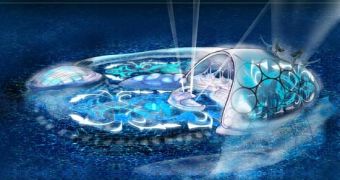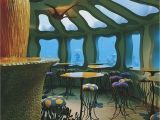The recent weather catastrophes, like hurricanes, tropical storms, massive rainfall, or rising sea levels have resulted in large areas of land being submerged. Consequently, countless homes have been abandoned, as the people who once claimed them are now left without a shelter.
But visionary ideas and eco-projects have brought a way to go around this problem, and integrate it in underwater living habitats, making the centuries-old dreams of authors like Jules Verne seem as a viable alternative and closer to happening. Among these, five stand as the most prominent, best technologically-adapted and most ecologically practical, although still far from addressing the large, regular public, but rather the people who can afford paying a visit from time to time.
Dubai's “Hydropolis Hotel,” conceived by Joachim Hauser, is a futuristic building currently undergoing construction 20 meters below the Persian Gulf's surface. This hardly qualifies as a regular household site, since it is designed to be the world's first undersea luxury hotel, also including an ocean research facility.
Rangali Island's “Hilton Maldives Undersea Restaurant” was raised in offshore Singapore, following the success of the Kuala Lumpur-based National Centre Aquarium’s design. Its covering Arch is made of acrylic and is sealed with silicon. The small 5-meter deep resort, designed for only 12 persons at a time, has given many headaches to its constructors who had to constantly review their calculations of gravity centers, weight distribution and the impact of tidal flows. This sort of questions the ease with which larger projects would be constructed.
Fiji's “Poseidon Undersea Resort” will lie 12 meters underneath the surface of a Fijian lagoon. It is still under construction in Portland, Oregon, and will be transported and placed at the site once it's done. It will consist of underwater “living pods,” which will offer great views of the surrounding waters and marine life at a weekly cost of $30,000.
Florida's “Jules' Undersea Lodge” was originally designed as an undersea research center for marine exploration off the Puerto Rican coast. The scuba-accessible 2-meter deep facility can house up to 6 visitors and show them the marvels of the Key Largo's Emerald Lagoon waters. It comprises 2 private rooms and a larger living area provided with a kitchen, all having large windows, being placed on 1.5-meter tall stilts and filled with compressed air in order to prevent waters from breaching them.
Finally, the Israeli “Red Sea Star Restaurant” has been conceived by the Israeli Ayala and Albi Serfaty (husband and wife)'s company “Aqua Creations,” and designed in such a fashion that everything within looks like a marine life form. Chairs are jellyfish, light bulbs resemble starfish – even the meals in the menu have marine shapes – and there's sand on the floor. Since the marine life in the Eilat reefs (where the resort is based) is either dead already or in the process of dying, the managing family recreated an artificial reef enclosing the restaurant, for a less morbid window view.
If projects like these prove to be a success without damaging the ecosystems around their building places in the process, like many people believe, this may yet convince more people to invest in undersea building. In the long run, construction prices would go down, better technology will allow for easier and more ecological construction and support solutions, and perhaps regular homes will begin to emerge, protecting people from the dangers of the surface coastal regions. However, given the current standards, this is still pretty far into the future.

 14 DAY TRIAL //
14 DAY TRIAL // 
